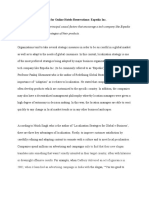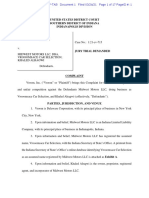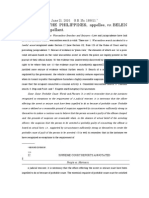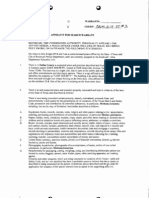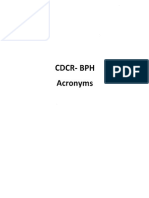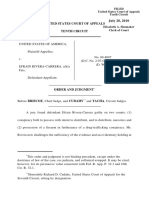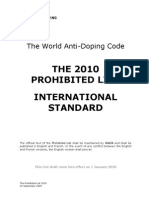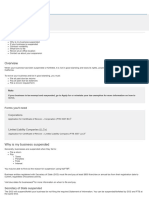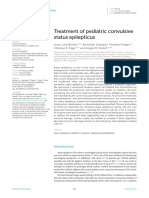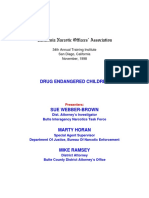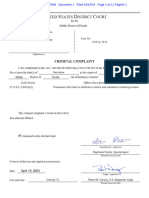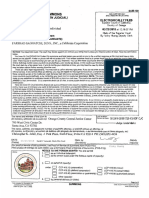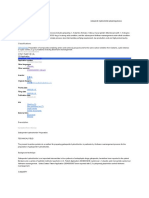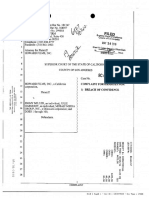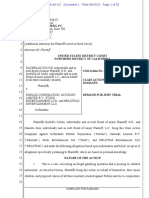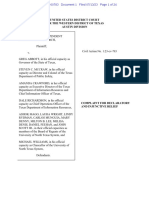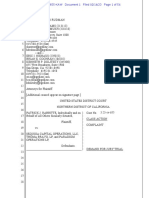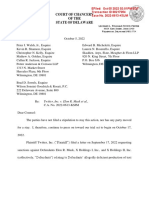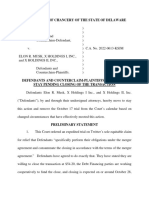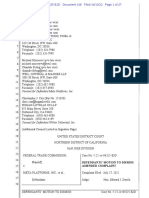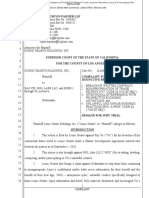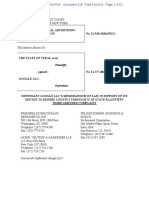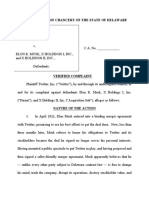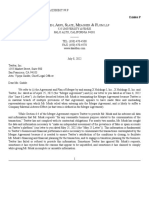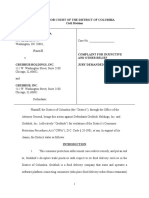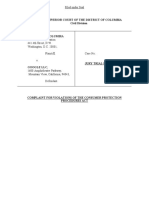0% found this document useful (0 votes)
5K views34 pagesSnapchat Fentanyl Case
Snapchat-fentanyl-case
Uploaded by
TechCrunchCopyright
© © All Rights Reserved
We take content rights seriously. If you suspect this is your content, claim it here.
0% found this document useful (0 votes)
5K views34 pagesSnapchat Fentanyl Case
Snapchat-fentanyl-case
Uploaded by
TechCrunchCopyright
© © All Rights Reserved
We take content rights seriously. If you suspect this is your content, claim it here.
/ 34
EHTOPTHZ
FILED
‘Superior Court of California,
BSuniy of Los Angeles
JAN 02 2024
‘avid W.Slayon, Exectve Ofte of Cout
By: A. Morales, Deputy
SUPERIOR COURT OF THE STATE OF CALIFORNIA
FOR THE COUNTY OF LOS ANGELES.
AMY NEVILLE; AARON NEVILLE; JAIME,
PUERTA; MARIAM HERNANDEZ; CINDY
CRUZ-SARANTOS; BRIDGETTE
NORRING; JAMES MCCARTHY;
KATHLEEN MCCARTHY; SAMANTHA,
MCCARTHY; MATTHEW CAPELOUTO;
CHRISTINE CAPELOUTO; PERLA
MENDOZA; SAMUEL CHAPMAN; DR.
LAURA ANN CHAPMAN BERMAN:
JESSICA DIACONT; E.B.; AND P.B.,
Plaintiffs,
v.
SNAP, INC.,
Defendant.
Case No.: 22STCV33500
ORDER SUSTAINING IN PART AND
OVERRULING IN PART DEFENDANT'S
DEMURRER TO PLAINTIFFS’ SECOND
AMENDED COMPLAINT
Hearing Date: October 18, 2023
Hearing Time: 11:00 a.m.
Dept.: 7
Plaintiffs assert’ that the conduct of defendant Snap, Inc. ("Snap"), a social media
company, has resulted in the foreseeable deaths of (and a serious personal injury to) their
children. The law of the State of California provides, or should provide, them with a
* Six other cases, asserting similar claims, are related, and assigned to this
department.
£OTOPTHT
remedy for their alleged losses, they say. Snap disagrees. Snap claims that none of
plaintiffs’ allegations, even if true, constitute a “cause of action.” Alternatively, Snap
claims that for one or more other reasons apparent from the face of plaintiffs’ operative
complaint, their lawsuit should be dismissed. Now before the court is Snap's demurrer to
the operative complaint.
Both sides contend that the law is clear and the legal path forward obvious. Not
80. The depth of disagreement is revealed by the parties’ inability jointly to label Snap's
social media presence and activities: “service,” “app,” product’, “tool,” “interactive course
of conduct,” “platform,” ‘website
‘software” or something else. What is clear and obvious
is that the law is unsettled and in a state of development in at least two principal regards:
(1) whether “section 230" (a federal statute) immunizes Snap from potential legal liability
under the specific allegations asserted and (2) whether concepts of strict products liability
— usually applicable to suppliers of tangible products — already do or now should extend
to specified alleged conduct of Snap.
Overview of the Case
Snap operates Snapchat, a social media app for smartphones that allows users to
send text, picture, and video messages, called “snaps,” to other users. (Second
Amended Complaint (July 20, 2023) ("SAC") | 19, 33.) Plaintiffs’ SAC is voluminous and
detailed: 216 pages and 991 separately numbered paragraphs. Its tenor is captured in
the first paragraph:
This case is about a social media product, Snapchat, that has caused
thousands of American teens to die from fentanyl overdoses. Despite Snap
promoting and portraying Snapchat as a “goofy” app for kids to use to send
each other silly pictures, its known common use is an “open air drug
market.” As detailed below, Snap and Snapchat's role in illicit drug sales to
teens was the foreseeable result of the designs, structures, and policies
Snap chose to implement increase its revenues. Worse, as the’predictable
use of Snapchat for drug sales—and deaths from fentanyl poisoning—took
off, Snap not only failed to make feasible changes to Snapchat to make the
app safer for kids, but it also engaged in a concerted corporate campaign
to delay and dissuade legal action. Snap falsely claimed it was taking
meaningful and effective steps to protect kids and when using the app, lying
to regulators and to grieving parents.
EQTORTOT
Although Snap has not yet formally responded to the allegations, itis clear from its
demurrer papers that it vehemently denies them. It asserts that it abhors the criminal
behavior of drug dealers who sold fentanyl to these minors; that it is on the frontlines to
stop drug dealers from engaging in this illegal conduct; that it has expended tremendous
financial and human capital resources to that end; and that it has worked closely and
cooperatively with law enforcement. More generally it contends that it promotes and
protects user safety for its 390 million daily users, and specifies some of its practices and
policies in furtherance of that goal. (Snap not only denies the allegations but seeks
monetary sanctions from plaintiffs’ counsel for their allegedly asserting allegations that
they know are false — a motion the court has set out for hearing in the future.)
Plaintiffs’ Legal Claims
Because this is a demurrer, which examines the legal sufficiency of allegations,
the court cites extensively to the SAC. The SAC claims that plaintifis are parents of
children who allegedly purchased illicit drugs from other Snapchat users. The plaintiff
parents allege that unknowingly, their children purchased drugs that contained fentanyl,
a synthetic opioid that can be lethal in small doses. (SAC, {] 24.) Except for A.B., the
child of plaintiffs E.B. and P.B., who survived a near-fatal fentanyl overdose, plaintifs’
children died of fentanyl poisoning after ingesting the drugs they obtained from other
Snapchat users. (Id. at {] 17.)
According to plaintiffs: Snapchat is specifically chosen by children, teens and
young adults for drug distribution because of how Snap designs, markets, distributes,
programs and operates Snapchat (SAC, {] 2); Snapchat's many data-deletion features
and functions made it foreseeable, if not intended, that Snapchat would become a haven
for drug trafficking (Id. at {] 3); the combination of practices and multiple features Snap
chose to build into its Snapchat product—such as ineffective age and identify verification,
facilitating easy creation of multiple, fake accounting, connecting kids with strangers and
drug dealers “in-app" through the “quick add” features and a live mapping feature makes
Snap an inherently dangerous product for young users (/d. at {] 13); Snap was on notice
that Snapchat was facilitating an enormous number of drug deals (/d. at | 14); Snap
ase
EOTOPTHZ
knowingly aided and abetted drug distribution to kids through its platform (id. at {| 15);
fentany| is highly toxic, is widely abused and has resulted in about 175 deaths per day in
the United States (id. at {| 23-32); Snapchat has evolved into a digital open-air drug
market, Snap has targeted minor users and misrepresented the safety of Snapchat, and
Snapchat is a “product” (/d. at if] 33-88); Snap has ineffective age verification and
parental controls, Snapchat's automatic message deletion feature facilitates illicit drug
sales and is unreasonably dangerous, Snapchat's screenshot notification and blocking
features discourage reporting illicit drug sales and are unreasonably dangerous,
Snapchat's “quick add” feature facilitates drug dealers’ targeting of minors with drug
menus and solicitations and is unreasonably dangerous, Snapchat's “stories” feature
facilitates drug dealers’ engagement with minors and is unreasonably dangerous,
‘Snapchat's "snap map" feature provides drug dealers with unique tools to evade detection
and is unreasonably dangerous, Snapchat's reporting mechanisms are defective, and
Snapchat's “my eyes only” feature facilitates illicit drug sales and is unreasonably
dangerous because it serves as a self-destructing vault to evade law enforcement (Id. at
‘TM 89-182); Snap relies on misleading messaging and attempts to spin, control, and
manage public outrage on Snapchat's status as an open-air drug market, Snap's role in
the drug trade has been reported to Snap within the media and law enforcement since at
least 2017, Snap ignored years’ worth of grieving parents’ warnings and requests for
Product modifications, Snap convinced grieving parents that they had no legal recourse,
rather than make meaningful changes to its product, Snap pursued a more than two year
strategy of false assurances and misdirection (/d. at ff] 183-268); Snap's re-direction
product modifications are ineffective (/d. at If] 269-276); and Snap actively frustrates law
enforcement efforts to prosecute criminals who sell illegal drugs on Snapchat (/d. at 1]
277-280). Plaintff-specific allegations are found in the SAC at paragraphs 299 through
719.
EOTOrTOT
@Nonron a=
"1
12
13
14
15
16
7
18
19
20
21
22
23
24
25
26
27
28
29
Plaintiffs disavow? any claim based upon Snap's activities as a publisher of the
third-party (drug seller) content. That is, plaintiffs do not contend that Snap is liable for
failing to eliminate or otherwise moderate some or all of the third-party drug sellers’
content. Instead, plaintiffs’ sole focus, they say, is on (1) Snap’s alleged independent
tortious conduct and (2) Snapchat (a “feature-packed social media app.”) as a defective
product. (Plaintiffs’ Opposition to Defendant Snap's Demurrer (Aug. 17, 2023)
(‘Opposition’) 3.)
So focusing, plaintiffs assert:
Snap developed and launched Snapchat for the express purpose of encouraging
and enabling lewd, illicit, and illegal conduct (SAC ff] 54-61, 1342, 723, 893). Snap
marketed and designed Snapchat to encourage and incentivize young users to
engage in inherently risky behavior and in a manner that prevented them from
appreciating and/or recognizing the risks Snap itself created (SAC ff 34, 41, 65-
72, 134-139, 141-143, 145-149, 156-159, 162-168, 177-182, 246, 723, 885).
Snapchat's artificial intelligence targets young users with drug advertisements
(SAC fif] 789, 146-158, 307-308, 324, 349-350, 382-383, 393, 414-415, 428, 444,
496-497, 529-531, 568-569, 603-605, 679-690) and affirmatively matches them to
‘Snapchat drug dealers (SAC ff] 49, 133-148, 245, 247, 307, 349, 382, 414, 418,
444, 496, 529, 568, 613, 626, 680, 687, 695, 705, 723, 911, 963). Snap designed
features to ensure accessibility by minors even where parents object and attempt
to keep their children away from Snapchat (SAC If] 48, 89-95, 102-112), prevents
parents and law enforcement from being able to monitor and protect those
children, and implements product changes and updates intended to render third
party monitoring software ineffective (SAC {ff} 106-108, 121-122, 170-174, 196,
223, 457, 468, 533, 619, 642-643, 748, 942(b).) Finally, Snap knowingly assisted
the drug dealers who flocked to Snapchat by designing several unique tools and
mechanisms to destroy and otherwise prevent the preservation of data. (SAC {ff}
60, 114-116, 119-120, 125-126, 130, 297-298, 431, 452, 546, 577-579).
(Opposition, 3.)
Plaintiffs have “allege[d] more than 21 specific design defects including a defective
age verification system, defective parental controls and reporting mechanisms, use of
? The sincerity, vel non, of their disavowal is not relevant. The issue is the legal
sufficiency of plaintiffs’ allegations, not their intentions. Footnote seven, below, comments
on “artful pleading” and “Lemmon-lingo.”
£OTHPTOT
eNaonrkrona
1
12
13
14
15
16
7
18
19
20
21
22
23
24
25
26
27
28
29
inherently dangerous products in connection with minor users, creating and sending
harmful notifications and communications, defective data retention policies or cooperate
[sic, “cooperation?’] with parents and law enforcement, the random and/or discriminatory
matchmaking between minors and adult strangers, defective system for implementing
limits on product downloads and account usage, and more. (SAC ff] 293-296, 731-754,
790, 869-870.)" (Opposition, 13.) Plaintiffs allege that Snapchat was also defective due
to inadequate warnings. (SAC {If 104-105, 112, 143, 160-166, 177, 221, 263, 271-272,
294, 761-781.)
Plaintiffs state their legal claims and theories in the form of 16 “counts,” thus
warranting a comment on vocabulary. To be sustained, a demurrer must dispose of the
entire complaint or an entire “cause of action.” (Code Civ. Proc., § 430.50, subd. (a);
Fremont Indemnity Co. v. Fremont General Corp. (2007) 148 Cal.App.4th 97, 113.) A
challenge to less than an entire cause of action in a pleading must be made by a motion
to strike, not demurrer. (Olson v. Hombrook Community Services Dist. (2019) 33
Cal App.Sth 502, 522, fn. 9.) Unlike our colleagues in the federal courts, California state
court judges have no ‘line-item veto" of allegations on a demurrer.
‘Snap has made no motion to strike.
There is diversity of language commonly used in the California Superior Court to
describe a plaintif's claim for relief and confusion surrounds the terms “cause of action”
and “counts.” (Bay Cities Paving & Grading, Inc. v. Lawyers’ Mutual Ins. Co, (1993) 5
Cal.4th 854, 860, fn.1 [terms “cause of action” and “counts” often used “imprecisely and
indiscriminately’].) Technically, a cause of action refers to a “primary right’ of a plaintiff,
a corresponding “primary duty” of a defendant, and a wrongful act by the defendant
constituting a breach of that duty. (Mycogen Corp. v. Monsanto Co. (2002) 28 Cal.4th
888, 904.) A cause of action is to be distinguished from both the relief sought (e.g.,
specific performance vs. damages) and “the legal theory on which liability for that injury
is premised: Even where there are multiple legal theories upon which recovery may be
COTORTOZ
predicated, one injury gives rise to one claim for relief.” (Ibid., emphasis and internal
quotes omitted.) The distinction — legal theory versus true cause of action — matters
when it comes to applying rules of claim preclusion, motions for summary adjudication,
and, as noted, demurrers.
In practice, parties often use “cause of action” or “count” to describe a legal theory
even though multiple “counts” stating various legal theories may all be directed to the
same “cause of action.” (Edmon & Karnow, Cal, Practice Guide: Civil Procedure Before
Trial (The Rutter Group 2023) {] 6:107.) For example, California recognizes a cause of
action for wrongful death, which may be pursued, based upon the facts, under legal
theories (‘counts’) of negligence or strict product liability.
Here, plaintiffs purport to assert 16 counts. (SAC, i] 720-991.) The court
understands plaintiffs intend to describe by each count a separate legal theory relating to
one or more true causes of action. Snap appears to share that understanding as its
demurrer is asserted to each such count (which Snap calls a cause of action.) The court
will employ plaintiffs’ language (and will substitute Arabic for Roman numerals). Plaintiffs’
counts are:
Count 1: Strict produit liability (design defect)
Count 2: Strict product liability (failure to warn)
Count 3: Risk benefit test (defective design)
Count 4: Negligence (design defect)
Count 5: Negligence (failure to warn)
Count 6: Negligence
Count 7: Negligence per se
Count 8: Tortious interference with parental rights
Count 9: Public nuisance
Count 10: Aiding and abetting
Count 11: Fraudulent concealment and misrepresentation
Count 12: Fraudulent misrepresentation
Count 13: Negligent misrepresentation
£OToréT9z
Count 14: Wrongful death
Count 15: Survival action
Count 16: Loss of consortium and society
Plaintiffs seek compensatory and punitive damages and declaratory and injunctive
relief. It appears to the court that the SAC actually asserts three causes of action in the
technical sense: wrongful death, personal injury, and public nuisance. And it alleges
multiple legal theories (‘counts") applicable to one or more of the causes of action, several
of which are sub-species of negligence and fraud. As the court understands it, “aiding
and abetting’ is neither a cause of action nor an independent legal theory, but a method
of extending and imposing liability upon an entity for the acts of another. (CACI No. 3610.)
The court understands the count denominated “loss of consortium and society” to be a
purported cause of action applicable to spouses, not parents, although a parent asserting
a wrongful death action may seek, as a species of damages, “loss of society” of a
deceased minor child. (CACI Nos. 3920, 3922.) The claim for “tortious interference with
parental rights” is asserted under Virginia law (Opposition, 33), and is discussed further
below.
The Nature of a Demurrer
‘A demurrer is not in any sense a test of the truth of any allegation or denial. Should
the case proceed, there are other phases of the proceedings where the truth or falsity of
allegations and denials are tested — principally trial, where the parties have the
opportunity to present to a factfinder information that meets the strictures of the Evidence
Code
The demurrer proceeding is far more limited. A demurrer raises one or more of
eight potential legal objections to a pleading. The grounds for the objection must “appear{]
on the face” of the complaint or “from any matter of which the court is required to or may
take judicial notice.” (Code Civ. Proc., §§ 430.10, 430.30, subd. (a).) Less abstractly, a
demurrer asks: assuming for argument that all of the factual allegations are true, do those
allegations constitute a “cause of action” — meaning, do they allege an invasion of a
legally protected interest for which the law, under one or more legal theories asserted,
COTOPTOT
@ONOaR ona
1
12
13
14
15
16
7
18
19
20
24
re]
23
24
25
26
27
28
29
provides appropriate relief? If so, the case proceeds. If not, normally the court provides
an opportunity for the plaintiffs to make additional or different allegations (‘leave to
amend’) if the plaintiffs request. Otherwise, the court dismisses some or all of the case
Here, however, plaintiffs have made clear they do not seek leave to amend should
the court find Snap's demurrer, or any part of it, has merit. They choose to stand on their
pleading.
In assuming the truth of the allegations of the SAC for the analysis of the demurrer,
‘the court does not employ a “plausibility” test as would be the case in federal court under
the analogous procedure to test the sufficiency of allegations in a complaint. (Bell Atlantic
Corp. v. Twombly (2007) §50 U.S. 544, 556-557; Ashcroft v. Iqbal (2000) 556 U.S. 662,
678-679 [district court disregards legal conclusions, determines whether factual
allegations “plausibly give rise to an entitlement for relief].) Instead, under California
procedure, “[aJs a general rule in testing a pleading against a demurrer{,] the facts alleged
in the pleading are deemed to be true, however improbable they may be.” (Del E. Webb
Corp. v. Structural Materials Co. (1981) 123 Cal.App.3d 593, 604.)
ANALYSIS.
Snap's Section 230 Challenge
Snap demurs “[t]o all causes of action alleged in the SAC — which are based on
content created and exchanged by third parties — [and which] are barred as a matter of
law under Section 230 of the Communications Decency Act.” (CDA) (Snap's Demurrer to.
Plaintiffs! Second Amended Complaint (Aug. 3, 2023) ("Demurrer’) 2.) Snap invokes
section 230 of title 47 of the United States Code (“section 230"), a federal statute
promulgated in 1996 that has generated an extensive jurisprudence. Federal circuit
courts of appeal, federal district courts, and state courts, including California state courts,
have considered and applied section 230 in a variety of factual circumstances
What law must this court apply?
As a state court, this court is bound by the United States Supreme Court's
interpretation of federal statutes (Mullaney v. Woods (1979) 97 Cal.App.3d 710, 719), but
eOTareoz
“the decisions of federal district and: circuit courts, although entitled to great weight, are
not binding on state courts even as to issues of federal law.” (Alan v. Superior Court
(2003) 111 Cal.App.4th 217, 229; Felisilda v. FCA US LLC (2020) 53 Cal.App.5th 486,
497.) By contrast, this court must apply a binding precedent of the California Court of
Appeal. (Auto Equity Sales, Inc. v. Superior Court (1962) 57 Cal.2d, 450, 455-456.)
Likewise, the California Court of Appeal is bound by the California Supreme Court's
interpretation of federal questions in the absence of a contrary decision of the United
States Supreme Court and despite contrary holdings of other federal courts. (People v.
Greenwood (1986) 182 Cal.App.2d 729, 734.) But when appellate decisions’ of the
California Court of Appeal are in conflict, “the court exercising inferior jurisdiction can and
must make a choice between the conflicting decisions.” (Auto Equity, at p. 456.)
The United States Supreme Court has not yet construed the immunizing reach of
section 230 with respect to the claims plaintiffs assert here, namely, (1) for the allegedly
tortious independent conduct of a social media company (independent, that is, of
“publishing” third-party conduct), and (2) for providing a defective social media platform
“product.” As to the first, there was anticipation in early 2023 that the court would decide
whether section 230 immunizes social media platforms for the act of recommending third-
Party content users. But it did not. “We therefore decline to address the application of
the section 230 to a complaint that appears to offer litle, if any, plausible claim for relief.”
(Gonzalez v. Google LLC (2023) 598 U.S 617, 622.)
The statute
Section 230(c)(1) provides:
Treatment of publisher or speaker: No provider or user of an interactive computer
service shall be treated as the publisher or speaker of any information provided by
another information content provider.
These are, it has been famously (and at this point monotonously) said, “the twenty-
six words that created the internet.” At least dozens if not hundreds of courts, academics,
and other commentators have by now explained that the provision was designed, in 1996,
to protect then-fledgling internet companies from incurring liability when millions of users
-10-
€aTarrag
enNnoarkrona
"1
12
13
14
15
16
17
18
19
20
21
22
23
24
25
26
27
28
29
posted content and when the companies made moves to police that content? Much of
the judicial and academic analysis has focused on an issue that is not involved in this
case, namely, the potential liability of a social media company for its decision to remove
or not to remove certain third-party content from its site. It seems clear that such
decisions are in the sweet spot of a traditional publisher's discretion and section 230
immunizes those decisions from tort liability. Plaintiffs’ theories here do not purport to
hold Snap liable for failing to remove some or all of the drug sellers’ third-party content
from Snapchat.
Congress expressed its intention with respect to the preemptive effect of section
230 on state law with a classic “consistenvinconsistent” construct:
Nothing in this section shall be construed to prevent any State from enforcing any
State law that is consistent with this section. No cause of action may be brought
and no liability may be imposed under any State or local law that is inconsistent
with this section,
(47 U.S.C. § 230(e)(3).) This construct kicks back to the courts to decide whether a state's
law including its tort common law is or is not consistent with section 230 — exactly what
this court is doing now.
‘And Congress also expressed its five policy goals in enacting section 230 in
subdivision (b)
itis the policy of the United States—
(1) to promote the continued development of the internet and other interactive
computer services and other interactive media;
(2) to preserve the vibrant and competitive free market that presently exists for
the Internet and other interactive computer services, unfettered by Federal
or State regulation;
3A few examples from the enormous literature in the academic and popular press
discussing the history and purpose of section 230 include an article by section 230's
preeminent historian, Kossoff, A User's Guide to Section 230, and a Legislator’s Guide to
Amending It (or Not) (2022) 37 Berk. Tech. L.J. 757; Klapper, Reading Section 230 (2022)
70 Buffalo L.Rev. 1237; Weintraub & Moore, Section 230 (2020) 4 Geo. L. Tech Rev.
625; and Rozenshtein, Interpreting the ambiguities of Section 230 (Oct. 26, 2023)
Brookings Institute [as of Dec. 27, 2023].)
-27-
£OLOrPZVT
products liability law does or should-apply in this case, but it will do so on a developed
factual record.
Snap’s Challenges to Negligence: Counts 4, 5, 6,7
In California, a plaintiff states a claim for negligence by alleging the existence of a
legal duty, a breach of that duty, harm caused by the breach, and resulting damages.
(Ladd v. County of San Mateo (1996) 12 Cal.4th 913, 917.) Civil Code section 1714,
subdivision (a) establishes a general duty for “everyone” to exercise ordinary care and
skill in their property or person. Failure to do so imposes responsibility for resulting injury
except where the injured person willfully or for want or ordinary care brought the injury
upon himself or herself.
Snap asserts that under the facts as alleged, it is evident that California law
recognizes an exception to the general rule of duty based on public policy. Snap invokes
the considerations identified by the California Supreme Court in Rowland v. Christian
(1968) 69 Cal.2d 108 which, when balanced together, justify a departure from the
fundamental principal embodied in section 1714, subdivision (a). These include the
foreseeability of harm to the plaintiff, the degree of certainty that the plaintiff suffered
injury, the closeness of the connection between the defendant's conduct and the injury
suffered, the moral blame attached to the defendant's conduct, the policy of preventing
future harm, the extent of the burden to the defendant and consequences to the
community of imposing a duty to exercise care with resulting liability for breach, and the
availability, cost and prevalence of insurance for the risk involved. (Id, at pp. 112-113.)
The court disagrees with Snap: the allegations of the SAC are sufficient to
establish the duty of reasonable care and do not establish as a matter of law an exception
under public policy. The California Supreme Court stated, “As we have explained,
however, in the absence of a statutory provision establish an exception to the general
tule of [section 1714, subdivision (a)], courts should create one only where clearly
18 In the modern era, California employs a comparative negligence regime to
reduce a plaintiffs damages attributable to his or her own fault in bringing about harm
-28-
CHOTORZBT
supported by public policy.” (Cabral v. Ralphs Grocery Co. (2011) 51 Cal.4th 764, 771
{internal quotes omitted).) Once again, however, the question of duty is not resolved for
all time. On a factual record, where the court has the ability to appropriately weigh the
competing policy factors, the question of the existence of duty may well come up again.
Snap also asserts that the SAC fails to allege causation. The court disagrees.
“The element of causation requires there to a connection between the defendant's breach
and the plaintiff's injury.” (Coyle v. Historic Mission Inn Corp. (2018) 24 Cal. App.5th 627,
645.) “A substantial factor in causing harm is a factor that a reasonable person would
consider to have contributed to the harm. It must be more than a remote or trivial factor.
It does not have to be the only cause of the harm.” (CACI No. 430.) The SAC alleges
causation sufficiently to survive attack by demurrer.
‘Snap demurs to count 6 (negligent failure to warn) on the basis that ‘the danger of
buying illegal drugs online is obvious, so no warning is required.” (Demurrer, 2.) The
SAC, however, alleges that the harm arose from a non-obvious danger, namely, the
presence of fentanyl in the drugs purchased by the minors. The SAC does not allege an
obvious danger for which no warning is required
With respect to count 7 (negligence per se), plaintiffs allege, “At all relevant times,
Snap had an obligation to comply with applicable statutes and regulations governing the
sale and distribution of illegal drugs to minors and distribution of controlled substances to
‘Americans more generally.” (SAC, {| 879.) Plaintiffs do not identify the statutes or
regulations. The negligence per se doctrine is codified in Evidence Code section 669
Under this doctrine, the plaintiff “borrows” statutes or regulations to establish a duty of
care and a standard of care. Proof of violation of the statute or regulation raises a
presumption of negligence which then may be rebutted by evidence showing justification
or an excuse for the violation. (David v. Hemandez (2014) 226 Cal. App.4th 578, 584;
Spriesterbach v. Holland (2013) 215 Cal.App.4th 255, 263.)
Snap's demurrer is premised on “failure to state facts sufficient to constitute a
cause of action” but does not demur on the grounds of uncertainty. (Code Civ. Proc., §
430.10, subds. (e)-(f).) The demurrer on this ground is overruled. Even were the
-29-
EOTOPZOT
demurrer based on uncertainty, it would be overruled. The statutes and regulations at
issue may be ascertained through the discovery process. Plaintiffs’ negligence per se
theories may be subject to later challenge once the statutes and regulations are identified
Rulings re: Negligence Challenges
Snap's demurrers to counts 4, 5, 6, and 7 are overruled
Snap’s Challenge to Tortious Interference with Parental Rights: Count 8
Plaintiff Jessica Diacont, a resident of Virginia, asserts Snap tortiously interfered
with her custodial rights and parental relationship arising from the death of her child,
Jacob. (SAC, {If 900-909.) She invokes Virginia state law'®; in the heading of count 8,
she refers to the Virginia Code Annotated, section 1-240.1."7 She explains in her
‘Opposition that the Virginia Supreme Court recognized the tort of interference in parental
rights in Wyatt v. McDermott (Va. 2012) 725 S.E.2d 555. She is correct. Borrowing from
extant Florida law, the Virginia Supreme Court stated the elements of this common law
tort including, as relevant here, that “a party outside of the relationship between the
complaining parent and his/her child intentionally interfered with the complaining parent's
parental or custodial relationship by removing or detaining the child from returning to the
complaining parent, without that parent's consent, or by otherwise preventing the
complaining parent from exercising his/her parental or custodial rights.” (Id. at p. 562.)
Plaintiff Diacont's theory apparently is not that the death of Jacob was the
interference at issue; it was the denial of the mother's parental ability to prevent access
to the Snapchat. (Opposition, 33.) Nowhere, however, does Diacont allege that Jacob's
access to Snapchat was without her consent
*® It is not clear whether the court would apply Virginia law and neither side briefs
the court on the choice-of-law question. For purposes of this demurrer only, the court will
assume that Virginia law applies.
This section reads, “A parent has a fundamental right to make decisions
concerning the upbringing, education, and care of the parent's child.”
-30-
L£OTOPTVE
Ruling re: Count 8
Assuming for argument that the Virginia law applies in this California proceeding,
the court sustains Snap's demurrer without leave to amend for failing to state facts
constituting a cause of action
Snap’s Challenge to Public Nuisance: Count 9
A claim for public nuisance requires allegations, among others, that the defendant,
by acting or failing to act, caused a “condition” that was harmful to health and that the
condition affected a substantial number of people at the same time. It is an offense
against the exercise of rights common to the public. (People ex rel. Gallo v. Acuna (1997)
14 Cal.4th 1090, 1103.) A “public right,” the California Supreme Court explained with
citation to section 8218 of the Second Restatement of Torts, “is common to all members
ofthe general public. It is collective in nature and not like the individual right that everyone
has not to be assaulted or defamed or defrauded or negligently injured.” (/d. at p. 1104.)
The essence of plaintiffs’ claims is that Snap's conduct resulting in the death (or
serious injury) to their specific children. While the SAC asserts that a substantial number
of other children have also died or been so injured, the rights involved are not “public
rights” designed to be vindicated by the law of nuisance. They are personal in nature.
Ruling re: Count 9
The court sustains Snap's demurrer without leave to amend.
Snap’s Challenges to Fraud, Concealment and Misrepresentation
Counts 14, 12 and 13
In California, a claim for fraudulent misrepresentation or concealment requires
pleading (a) misrepresentation (false representation, concealment or nondisclosure); (b)
knowledge of falsity (scienter); (c) intent to defraud, i., to induce reliance; (d) justifiable
reliance; and (e) resulting damage. (Engalla v. Permanente Medical Group, Inc. (1997)
15 Cal.4th 951, 974.) Negligent misrepresentation does not include the element of intent
to deceive. (Moncada v. West Coast Quartz Corp. (2013) 221 Cal.App.4th 768, 781.)
The pleading requirements for fraud require particularity and specificity: how, when,
where, to whom, and by what means the representations were tendered. (Lazar v.
-31-
COTOPTBT
Superior Court (1996) 12 Cal.4th 631, 645.) Witkin explains, “The effect of this rule is
twofold: (a) general pleading of the legal conclusion of “fraud” is insufficient; the facts
constituting the fraud must be alleged; and (b) every element of the cause of action for
fraud must be alleged in the proper manner (i.e., factually and specifically), and the policy
of liberal construction of the pleadings [citation omitted] will not ordinarily be invoked to
sustain a pleading defective in any material respect.” (5 Witkin, Cal. Procedure (6th ed.
2023) Pleading, § 707.)
Snap asserts that plaintiffs have failed to meet the particularity and specificity
requirements; plaintiffs assert they have and direct the court to footnotes 26 and 27 of
their Opposition, citing specific paragraphs of the SAC.
The court finds that the allegations contained in paragraph 942, subsections (a)
through (/), at a minimum, are sufficiently particular and specific to meet the pleading
standard. The allegations of reliance likewise are sufficient. Given that a demurrer must
eliminate an entire cause of action, these allegations are sufficient to overcome the
demurrer,
In so finding, the court has in mind the Court of Appeat's explanation in West v.
JPMorgan Chase Bank, N.A. (2013) 214 Cal. App.4th 780, 793 (West) (cleaned up): ‘We
enforce the specificity requirement in consideration of its purposes. The first purpose is
to give notice to the defendant with sufficiently definite charges that the defendant can
meet them. [Citations omitted.] The second is to permit a court to weed out meritless
fraud claims on the basis of the pleadings; thus, the pleadings should be sufficient to
enable the court to determine whether, on the facts pleaded, there is any foundation,
prima facie at least, for the charge of fraud.”
Here, the SAC has sufficiently apprised Snap of the allegations of fraud,
concealment, and misrepresentation (which may or may not be supplemented by
information obtained in discovery). “Prima facie” — meaning assuming the allegations
are true — the court finds the SAC meets the “any foundation’ test of West.
Ruling re: Fraud, Concealment and Misrepresentation
The court overrules Snap’s demurrer to counts 11, 12 and 13.
-32-
LOTOPTHZ
Snap's Challenges to Counts 14, 15 and 16
Rulings
Snap's demurrer to count 14 (wrongful death) and 15 (survival action) are
overruled. The allegations are sufficient to state causes of action for wrongful death and
survival under California law.
Snap’s demurrer to count 16 ("loss of consortium and society’) is sustained without
leave to amend because California law recognizes no cause of action for parents of
minors. This ruling does not affect any entitlement under law for the recovery of damages
under a recognized legal theory.
Snap’s Statute of Limitations Challenges
Snap asserts that some of plaintiffs Chapmans’ and Diacont's claims are time-
barred by California (or Virginia's"®) two-year statute of limitations. Plaintiffs respond by
invoking the delayed discovery rule. (Fox v. Ethicon Endo-Surgery, Inc. (2005) 36 Cal.4th
797, 803.) On reply, Snap argues that the delayed discovery allegations in the SAC are
“implausible.” (Reply, 20.) Plausibility, however, is not the test on demurrer in the
California state courts
Rulings
Snap's demurrers, as presented, based on the statute of limitations are overruled.
To the extent Virginia law applies to a claim and such law provides a defense under a
statute of limitations, the matter may be raised later on a motion for summary judgment.
CONCLUSION
‘Snap's demurrers to counts 1, 2, 3, 4, 5, 6, 7, 11, 12, 13, 14 and 15 are overruled
‘Snap's demurrers to counts 8, 9, 10 and 16 are sustained without leave to amend
(recall, plaintiffs do not seek leave to amend.)
"8 Again, neither side briefs the court on the applicability of Virginia law including
whether Virginia recognizes a delayed discovery rule
-33-
£OTOPTIZ
ON OHRON A
©
1
12
13
14
15
16
7
18
19
20
ne
22
23
24
25
26
27
28
29
‘Snap is ordered to file its answer to the SAC within 30 days of service of this order.
2
AWRENCE P. RIFF
OF THE SUPERIOR COURT
Dated: January 2, 2024
-34-


